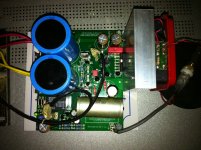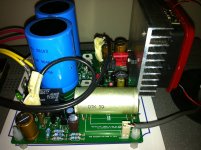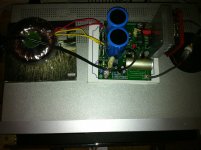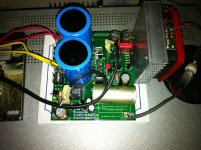bcmbob
thanks! I will try later connecting Alps alone, hope it would solve the issue as active preamp is an overkill anyway, imo. Perhaps Salas hot rodded buffer that I'm building now would be even better here.
AndrewT
I will check it with my AB class amp with 2x100VA toroids, lets see what this meter shows there.
thanks! I will try later connecting Alps alone, hope it would solve the issue as active preamp is an overkill anyway, imo. Perhaps Salas hot rodded buffer that I'm building now would be even better here.
AndrewT
I will check it with my AB class amp with 2x100VA toroids, lets see what this meter shows there.
I use the same config: passive attenuation (Alps) > DCB1 (hotrodded) >MyRef
DCB1 improves a lot mid frq (voices) and stereo image.
DCB1 improves a lot mid frq (voices) and stereo image.
Last edited:
You knew they were comming 😀
BLAT I - Soft crusted Belgian 1 hour from the bakers oven. A little MW with a splash of Italian Dressing.
BLAT II - Hard crust light sourdough, Canadian Bacon, topped with chopped onion and avocado.
Two of the best momoblocks I've ever built. One actually has high quality chips installed 😉
Thanks Jac
BLAT I - Soft crusted Belgian 1 hour from the bakers oven. A little MW with a splash of Italian Dressing.
BLAT II - Hard crust light sourdough, Canadian Bacon, topped with chopped onion and avocado.
Two of the best momoblocks I've ever built. One actually has high quality chips installed 😉
Thanks Jac

Attachments
mine has very noticeable grounding sound (not placed in enclosure yet) - some kind of low frequency hum even if the pcb's input socket is completely disconnected.
With input disconnected a slight hum is perfectly normal but it should disappear completely with source connected.
the preamp I use has approximately 3x gain, 10k Alps pot and it seems it's a bit overkill. Is everybody using just a pot or some passive preamp? What would be better?
I'm using plain 10K pot, DCB1 with 10k pot, AV receiver pre-out without problems or hum.
I've built too a JC2 but I get hum.
BTW no preamp is needed with the MyRef (Rev C or FE)
every time I switch off my preamp I get very loud snap or crack in the speakers, then relay clicks, LED is off and amp needs to be turned off and on. Is there any simple output stage that could be added after opamp to prevent this? Moreover, I have already burned somehow 1R resistor and T201 doing similar switching yesterday, not sure was it the volume level or the series of turning on and off my preamp, but in the end i've got not working FE and spent hours to figure out what was fried... 😀
This is not normal, definitively.
Are you sure you correctly wired signal hot and ground return?
If you invert hot with ground return hearing hum is a certainty... 😉
I've built too a JC2 but I get hum.
No more hum from my JC2 as a pre for the FE...it was simply a bad contact through the Molex connector...
So, in my case, I can't get hum from any active/passive pre I've tried (if correctly wired 😉 ).
Last edited:
That's great Dario, I hope you like how it sounds as much as I do.
I've been thinking about using a tiny screw terminal also on all the signal ins on the FEs, as I had a similar problem with those little spurs on the connector failing. It will be great when everything is a soldered joint.
Happy listening and let us know your impressions.
I've been thinking about using a tiny screw terminal also on all the signal ins on the FEs, as I had a similar problem with those little spurs on the connector failing. It will be great when everything is a soldered joint.
Happy listening and let us know your impressions.
thanks, Dario, for help 🙂
could you please eleborate this? did you mean pot?
One more thing that would like to clarify if that is normal behaviour. Once I connect socket to the mains, push the switch on button, FE doesn't start, it does only when the switch is turned off and on again. 😕
The other a bit confusing thing is if you play with the mains switch for several times - FE doesn't turn on any longer, you should turn it off, wait for 2-3 secs and only then it's working.😕
If you invert hot with ground return hearing hum is a certainty... 😉
could you please eleborate this? did you mean pot?
One more thing that would like to clarify if that is normal behaviour. Once I connect socket to the mains, push the switch on button, FE doesn't start, it does only when the switch is turned off and on again. 😕
The other a bit confusing thing is if you play with the mains switch for several times - FE doesn't turn on any longer, you should turn it off, wait for 2-3 secs and only then it's working.😕
dtses, are you using sockets in your build? If so, are they maintaining good contact? A loose fit can easily interrupt the circuit.
thanks, Dario, for help 🙂
You're welcome 🙂
could you please eleborate this? did you mean pot?
No, I mean connecting source hot to FE ground and source ground to FE hot.
Once I connect socket to the mains, push the switch on button, FE doesn't start, it does only when the switch is turned off and on again. 😕
The other a bit confusing thing is if you play with the mains switch for several times - FE doesn't turn on any longer, you should turn it off, wait for 2-3 secs and only then it's working.😕
There is something wrong, this beahviour is absolutely not normal.
I would check all resistors value and correct assembly.
BTW: Don't know if anyone else was a little confused about the use of the HSGND pad and the message nearby. Dario explained - if the heatsink is part of the (safety earth connected) chassis or has continuity to it, that pad should not be connected.
If the heatsink is electrically isolated from the chassis, the HSGND connection should be used - though it may not be absolutely necessary. Simple enough even for me. 🙄
If the heatsink is electrically isolated from the chassis, the HSGND connection should be used - though it may not be absolutely necessary. Simple enough even for me. 🙄
dtses, are you using sockets in your build? If so, are they maintaining good contact? A loose fit can easily interrupt the circuit.
hi mate,
I'm pretty sure that the contact is good and tight, this shouldn't be the problem.
I would check all resistors value and correct assembly.
indeed that helped 🙂 checked all resistors and R2 turned out to be 270R instead of 10k, I should have checked that in the shop, their mistake. At least one issue is solved - relay and LED works perfectly now!
BTW: Don't know if anyone else was a little confused about the use of the HSGND pad and the message nearby. Dario explained - if the heatsink is part of the (safety earth connected) chassis or has continuity to it, that pad should not be connected.
If the heatsink is electrically isolated from the chassis, the HSGND connection should be used - though it may not be absolutely necessary. Simple enough even for me. 🙄
thanks, Bob! pretty clear it's now!
However, I assume the problem is somewhere else as I have tied to run FE simply with a single pot nothing else and I've got the same grounding hum. I do not use any chassis or metal things that could cause that, so I'm really confused now...
There are several things that I would like to say more:
-testing assembled channel for several hours I've got only 1.6mV DC offset, actually didn't even expect it to be that low 🙂
-with rather trivial heatsink (it's only temporary on the pics) amp gets only to some 40-45c, not more.
-the PCB is so splendid, I've got the most pleasant soldering experience I've ever had! I would compare it with my favorite Italian vine Brunello di Montalcino. Perfect look, fragrant smell, unforgettable and very distinctive taste, feeling that you are drinking/ soldering indeed something very special! DARIO, don't know how did you manage, but it's outstanding! both the pbc and the work you've done!🙂
-I have burned R11 (1 ohm) once more time by my mistake. Perhaps it would be better to use some 1w or even 2w resistor here?
One thing I was really disappointed:
not sure if that is so or that grounding sound I experience somehow affects on that, but I feel some kind of bass leakage in comparison to my modified Restek Fantasy that is kind of reference for me. I feel it's not so deep and articulated in FE and the bad thing is that it's quite noticeable. Again, not sure if it really should be so...Perhaps Dario could elaborate this 😕
I have attached the pics. There are still several parts I'm waiting for, so temporary put these big 10k uf caps, few resistors, heatsink with a fan (didn't even turn it on, no need).
Attachments
Hum 1
Dtses,
I feel for you. It's frustrating to have a problem like this and not find the reason. I looked but didn't see anything except the fan. Hopefully others can notice something else as I am having no hum issues, nor lack of bass. Regarding the fan, is it possible that the fan is introducing the hum?
Jac
Dtses,
I feel for you. It's frustrating to have a problem like this and not find the reason. I looked but didn't see anything except the fan. Hopefully others can notice something else as I am having no hum issues, nor lack of bass. Regarding the fan, is it possible that the fan is introducing the hum?
Jac
Hum and Transformers
I've been curious about measuring hum and have given it a try. It seems like there are build related hum problems (which I can't help with) and base design hum that is in every amplifier at some level. I want to qualify everything here by saying that I don't have the experience, expertise, or equipment that some of our more expert forum member have. If I am testing or interpreting results incorrectly, I am totally open to suggestion.
First, the limitations of my equipment. I am using a program (LAUD v3) that was design for speaker testing and a sound card that has a 97 dB S/N (note bad but not good enough), a 20 bit sample size, and a max of 48 kHz sampling rate which limits the results to 20 kHz.
Most of my hum testing was done with RTA over a range of 20 to 1000 Hz as this should cover most of the hum related noise. I did look out to 20 kHz and found the upper frequencies quiet.
Although I looked at a range of resistance across the inputs, most of my testing was done with the inputs shorted as shown in this picture of the test board. I did all of my testing by measuring the output of one channel.

My first step was to measure the frequency response of the amplifier from 20 to 20k Hz. Naturally, the input was not shorted for this test. The input signal was a 1 volt sine wave swept though the frequency range. The vertical scale is 1 dB/div. Note that there is no noise at 60 or 120 Hz indicating a lack of hum compared to the input signal.

I then measured the output of the amp with no signal and a shorted input. This approach used the RTA instrument which gave me trouble saving it's graphs, but I recorded the results. In this configuration, I was able to measure hum at 60 Hz of 42 dBmV which converts to 135 mV at the output. To put this in perspective, if you had an 8 ohm, 90 dB sensitivity speaker, 135 mV would produce about 5 dB if I did my math right. The next peak in the noise curve was at about 320 Hz and 14 mV. If my methods are correct, I would say that the FE is quite good for hum.
Both Mauro and Klaus have hinted that one transformer per board is a good idea for hum due to the FE's dual diode bridge in the power supply. At one point Klaus was going to explain the theory, but the conversation moved on. I was interested to see if I could measure any difference in hum between monoblocks and 2 FE's power from one transformer in parallel. Please note that my experiment is not conclusive because I don't have a metal chassis nor any ground connection between the power supply/mains and the signal ground.
My result was no measurable difference between 2 monoblocks and 1 transformer/2 FE. Pardon the blurry picture, but it shows the parallel power supply.

Finally, I explored some of the ideas suggested by Klaus and others. I measured the hum with the input shorted, with a 10 ohm resistor, with a 100k ohm resistor, and open circuit. All measured the essentially the same. I also used a clip lead to jumper R11 which Klaus believes amplifies noise. It may be possible that it amplifies noise, but it does not appear to be in the path of any hum energy as the hum voltage at the output remained constant.
I hope this is of interest to others. Are there other configurations I should have checked?
Jac
I've been curious about measuring hum and have given it a try. It seems like there are build related hum problems (which I can't help with) and base design hum that is in every amplifier at some level. I want to qualify everything here by saying that I don't have the experience, expertise, or equipment that some of our more expert forum member have. If I am testing or interpreting results incorrectly, I am totally open to suggestion.
First, the limitations of my equipment. I am using a program (LAUD v3) that was design for speaker testing and a sound card that has a 97 dB S/N (note bad but not good enough), a 20 bit sample size, and a max of 48 kHz sampling rate which limits the results to 20 kHz.
Most of my hum testing was done with RTA over a range of 20 to 1000 Hz as this should cover most of the hum related noise. I did look out to 20 kHz and found the upper frequencies quiet.
Although I looked at a range of resistance across the inputs, most of my testing was done with the inputs shorted as shown in this picture of the test board. I did all of my testing by measuring the output of one channel.
My first step was to measure the frequency response of the amplifier from 20 to 20k Hz. Naturally, the input was not shorted for this test. The input signal was a 1 volt sine wave swept though the frequency range. The vertical scale is 1 dB/div. Note that there is no noise at 60 or 120 Hz indicating a lack of hum compared to the input signal.
I then measured the output of the amp with no signal and a shorted input. This approach used the RTA instrument which gave me trouble saving it's graphs, but I recorded the results. In this configuration, I was able to measure hum at 60 Hz of 42 dBmV which converts to 135 mV at the output. To put this in perspective, if you had an 8 ohm, 90 dB sensitivity speaker, 135 mV would produce about 5 dB if I did my math right. The next peak in the noise curve was at about 320 Hz and 14 mV. If my methods are correct, I would say that the FE is quite good for hum.
Both Mauro and Klaus have hinted that one transformer per board is a good idea for hum due to the FE's dual diode bridge in the power supply. At one point Klaus was going to explain the theory, but the conversation moved on. I was interested to see if I could measure any difference in hum between monoblocks and 2 FE's power from one transformer in parallel. Please note that my experiment is not conclusive because I don't have a metal chassis nor any ground connection between the power supply/mains and the signal ground.
My result was no measurable difference between 2 monoblocks and 1 transformer/2 FE. Pardon the blurry picture, but it shows the parallel power supply.
Finally, I explored some of the ideas suggested by Klaus and others. I measured the hum with the input shorted, with a 10 ohm resistor, with a 100k ohm resistor, and open circuit. All measured the essentially the same. I also used a clip lead to jumper R11 which Klaus believes amplifies noise. It may be possible that it amplifies noise, but it does not appear to be in the path of any hum energy as the hum voltage at the output remained constant.
I hope this is of interest to others. Are there other configurations I should have checked?
Jac
That's great Jac, Glad someone got started. Just to be clear, you are talking only about measured hum - right? Can you hear anything from your speakers that correlates to the peaks? Is your sub on line yet?
relay and LED works perfectly now!
Fine 🙂
However, I assume the problem is somewhere else as I have tied to run FE simply with a single pot nothing else and I've got the same grounding hum.
Did you checked hot and ground input?
Connectors?
-testing assembled channel for several hours I've got only 1.6mV DC offset, actually didn't even expect it to be that low 🙂
Really a good result. 🙂
the PCB is so splendid, I've got the most pleasant soldering experience I've ever had! (...) DARIO, don't know how did you manage, but it's outstanding! both the pbc and the work you've done!🙂
Thanks! 🙂
Yes, the italian PCB maker done a much better job than the chinese one I've used for beta boards. I'm really satisfied (the italian product cost much more, though)
-I have burned R11 (1 ohm) once more time by my mistake. Perhaps it would be better to use some 1w or even 2w resistor here?
No, that resistor is also a sort of safety measure... it's better to change a single resistor than much more costly parts...
not sure if that is so or that grounding sound I experience somehow affects on that, but I feel some kind of bass leakage in comparison to my modified Restek Fantasy that is kind of reference for me.
You're using a different BOM so result may vary... but on this post on the beta thread you can see that I was using a Takman too and had similar problems.
Simply reverse it. 😉
That's great Jac, Glad someone got started. Just to be clear, you are talking only about measured hum - right? Can you hear anything from your speakers that correlates to the peaks? Is your sub on line yet?
Bob,
You are correct. This is only about hum. To be more specific, there is no music, there are no speakers or subwoofer. It is just the FE amp, on a bench, mostly with the no signal going in and the input shorted to audio ground. All I am doing is measuring voltage at the output that is coming from the power supply through the amp.
The graph in the picture also doesn't have any music or sound. It does have an input signal and, in that sense, is more typical of when you play music.
As for hearing the 60 Hz hum, I don't think you would be able to, were speakers connected. A quiet room is, maybe, 40 dB. I was calculating that a relatively efficient speaker (90 dB) would only put out 5 dB at 60 Hz. Of course, since the 5 dB is calculated from the 90 dB sensitivity (which is at 1 meter), then the 5 dB is also at 1 meter. Of course, if you could get your ear 10 mm from the dust cap, then the 5 dB would be 45 dB and might be just audible. Still, pretty low hum.
Again, I'm not sure I'm measuring this the best possible way. Any expert comment?
Jac
Last edited:
First, the limitations of my equipment. I am using a program (LAUD v3) that was design for speaker testing and a sound card that has a 97 dB S/N (note bad but not good enough), a 20 bit sample size, and a max of 48 kHz sampling rate which limits the results to 20 kHz.
Your measurement setup might induce ground loops into the system and give false readings. If you use a laptop, disconnect everything from it that isn't directly needed for the measurement and run on battery only.
My first step was to measure the frequency response of the amplifier from 20 to 20k Hz. Naturally, the input was not shorted for this test. The input signal was a 1 volt sine wave swept though the frequency range. The vertical scale is 1 dB/div. Note that there is no noise at 60 or 120 Hz indicating a lack of hum compared to the input signal.
Is that 1 volt RMS, peak, or peak to peak? Is there an attenuator anywhere in the input signal path? 1 volt RMS should put the amplifier well into clipping.
I then measured the output of the amp with no signal and a shorted input. This approach used the RTA instrument which gave me trouble saving it's graphs, but I recorded the results. In this configuration, I was able to measure hum at 60 Hz of 42 dBmV which converts to 135 mV at the output. To put this in perspective, if you had an 8 ohm, 90 dB sensitivity speaker, 135 mV would produce about 5 dB if I did my math right. The next peak in the noise curve was at about 320 Hz and 14 mV. If my methods are correct, I would say that the FE is quite good for hum.
135 mV is very high for hum output. I calculate that to be 2.2mW which should produce an SPL of 64dB. If you don't hear hum from the speaker, the measurement is wrong. Spectral peaks should be at 60 Hz harmonics - 120, 180, 240, 300, 360. There should be no hum related peak at 320.
AC output of the power amp with the input shorted should be less than 1mVac.
It is better if you can get that output voltage down below 0.3mVac.
I get virtually all my monoblock no chassis amps to read 0.0mVac, indicating ~<0.05mVac.
But some amplifiers can be quieter, I have no idea if any of my builds are quieter, because I can't measure any lower.
I suspect you conversion
It is better if you can get that output voltage down below 0.3mVac.
I get virtually all my monoblock no chassis amps to read 0.0mVac, indicating ~<0.05mVac.
But some amplifiers can be quieter, I have no idea if any of my builds are quieter, because I can't measure any lower.
I suspect you conversion
is wrong.I was able to measure hum at 60 Hz of 42 dBmV which converts to 135 mV at the output.
- Status
- Not open for further replies.
- Home
- Amplifiers
- Chip Amps
- My_Ref Fremen Edition RC - Build thread


